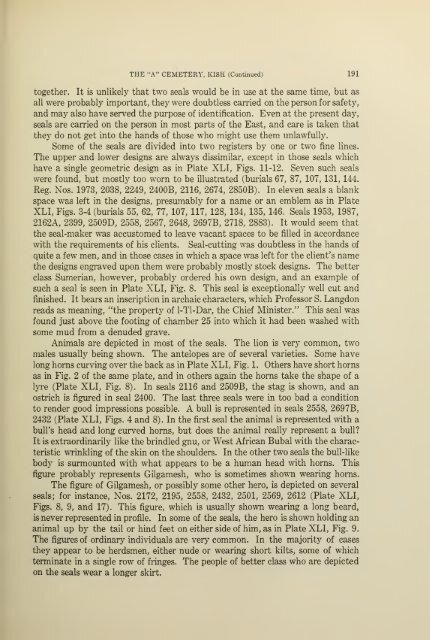A Sumerian Palace and the "A" cemetery at Kish, Mesopotamia
A Sumerian Palace and the "A" cemetery at Kish, Mesopotamia
A Sumerian Palace and the "A" cemetery at Kish, Mesopotamia
Create successful ePaper yourself
Turn your PDF publications into a flip-book with our unique Google optimized e-Paper software.
THE "A" CEMETERY, KISH (Continued) 191<br />
toge<strong>the</strong>r. It is unlikely th<strong>at</strong> two seals would be in use <strong>at</strong> <strong>the</strong> same time, but as<br />
all were probably important, <strong>the</strong>y were doubtless carried on <strong>the</strong> person for safety,<br />
<strong>and</strong> may also have served <strong>the</strong> purpose of identific<strong>at</strong>ion. Even <strong>at</strong> <strong>the</strong> present day,<br />
seals are carried on <strong>the</strong> person in most parts of <strong>the</strong> East, <strong>and</strong> care is taken th<strong>at</strong><br />
<strong>the</strong>y do not get into <strong>the</strong> h<strong>and</strong>s of those who might use <strong>the</strong>m unlawfully.<br />
Some of <strong>the</strong> seals are di\'ided into two registers by one or two fine lines.<br />
The upper <strong>and</strong> lower designs are always dissimilar, except in those seals which<br />
have a single geometric design as in Pl<strong>at</strong>e XLI, Figs. 11-12. Seven such seals<br />
were found, but mostly too worn to be illustr<strong>at</strong>ed (burials 67, 87, 107, 131, 144.<br />
Reg. Nos. 1973, 2038, 2249, 2400B, 2116, 2674, 2850B). In eleven seals a blank<br />
space was left in <strong>the</strong> designs, presumably for a name or an emblem as in Pl<strong>at</strong>e<br />
XLI, Figs. 3-4 (bui'ials 55, 62, 77, 107, 117, 128, 134, 135, 146. Seals 1953, 1987,<br />
2162A, 2399, 2509D, 2558, 2567, 2648, 2697B, 2718, 2883). It would seem th<strong>at</strong><br />
<strong>the</strong> seal-maker was accustomed to leave vacant spaces to be filled in accordance<br />
with <strong>the</strong> requirements of his clients. Seal-cutting was doubtless in <strong>the</strong> h<strong>and</strong>s of<br />
quite a few men, <strong>and</strong> in those cases in which a space was left for <strong>the</strong> client's name<br />
<strong>the</strong> designs engraved upon <strong>the</strong>m were probably mostly stock designs. The better<br />
class <strong>Sumerian</strong>, however, probably ordered his own design, <strong>and</strong> an example of<br />
such a seal is seen in Pl<strong>at</strong>e XLI, Fig. 8. This seal is exceptionally well cut <strong>and</strong><br />
finished. It bears an inscription in archaic characters, which Professor S. Langdon<br />
reads as meaning, "<strong>the</strong> property of 1-Tl-Dar, <strong>the</strong> Chief Minister." This seal was<br />
found just above <strong>the</strong> footing of chamber 25 into which it had been washed with<br />
some mud from a denuded grave.<br />
Animals are depicted in most of <strong>the</strong> seals. The lion is very common, two<br />
males usually being shovvm. The antelopes are of several varieties. Some have<br />
long horns curving over <strong>the</strong> back as in Pl<strong>at</strong>e XLI, Fig. 1. O<strong>the</strong>rs have short horns<br />
as in Fig. 2 of <strong>the</strong> same pl<strong>at</strong>e, <strong>and</strong> in o<strong>the</strong>rs again <strong>the</strong> horns take <strong>the</strong> shape of a<br />
lyre (Pl<strong>at</strong>e XLI, Fig. 8). In seals 2116 <strong>and</strong> 2509B, <strong>the</strong> stag is shown, <strong>and</strong> an<br />
ostrich is figui'ed in seal 2400. The last three seals were in too bad a condition<br />
to render good impressions possible. A bull is represented in seals 2558, 2697B,<br />
2432 (Pl<strong>at</strong>e XLI, Figs. 4 <strong>and</strong> 8). In <strong>the</strong> first seal <strong>the</strong> animal is represented with a<br />
bull's head <strong>and</strong> long curved horns, but does <strong>the</strong> animal really represent a bull?<br />
It is extraordinarily like <strong>the</strong> brindled gnu, or West African Bubal with <strong>the</strong> charac-<br />
teristic wrinkling of <strong>the</strong> skin on <strong>the</strong> shoulders. In <strong>the</strong> o<strong>the</strong>r two seals <strong>the</strong> bull-like<br />
body is surmounted with wh<strong>at</strong> appears to be a human head with horns. This<br />
figure probably represents Gilgamesh, who is sometimes showm wearing horns.<br />
The figure of Gilgamesh, or possibly some o<strong>the</strong>r hero, is depicted on several<br />
seals; for instance, Nos. 2172, 2195, 2558, 2432, 2501, 2569, 2612 (Pl<strong>at</strong>e XLI,<br />
Figs. 8, 9, <strong>and</strong> 17). This figure, which is usually shown wearing a long beard,<br />
is never represented in profile. In some of <strong>the</strong> seals, <strong>the</strong> hero is shown holding an<br />
animal up by <strong>the</strong> tail or hind feet on ei<strong>the</strong>r side of him, as in Pl<strong>at</strong>e XLI, Fig. 9.<br />
The figures of ordinary' individuals are veiy common. In <strong>the</strong> majority of cases<br />
<strong>the</strong>y appear to be herdsmen, ei<strong>the</strong>r nude or wearing short kilts, some of which<br />
termin<strong>at</strong>e in a single row of fiinges. The people of better class who are depicted<br />
on <strong>the</strong> seals wear a longer skirt.

















